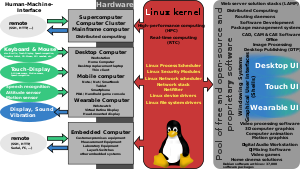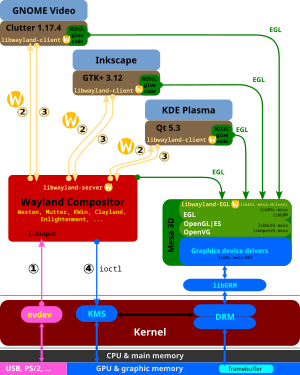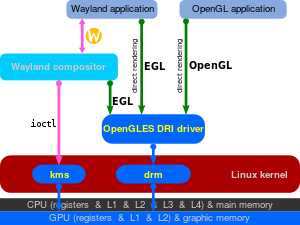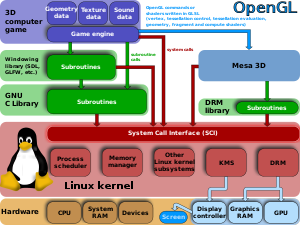Wikipedia:WikiProject Desktop Linux
| This WikiProject is believed to be inactive. Consider looking for related projects for help or ask at the Teahouse.
If you are not currently a project participant and wish to help you may still participate in the project. This status should be changed if collaborative activity resumes. |








This project started to address the problem of un-maintained articles relating to free and open-source operating systems with a graphical shell based on the Linux kernel.
The points
editLinux kernel-based ...
editArticle structure over multiple articles:
- Linux kernel – article is correctly constrained to describing the kernel and not any operating system
- Linux – article about the family of operating systems; this article has been a mess for years and the article Linux distribution doesn't quite do the job either.
- Linux range of use – outsourcing of the above article to get some breathing room
- Linux for servers – a distinct article could be of use; ATM there is only LAMP (software bundle); what about Linux as router OS with BIRD, B.A.T.M.A.N., Quagga and XORP? What about Linux-based MTAs or mail-servers? What about LDAP-servers? What about OpenStack? Virtualization stacks? There should be enough for entire article.
- Linux on the home computer – everything with a UI, for me this encompasses ⇒ Template:Single-board computers such as the Raspberry Pi (kudos to their marketing success)
- Linux as a gaming platform – everything related to playing games and developing games: SDL, SFML, VOGL, Valgrind and co.; SteamOS and Pandora's OS
- Linux for mobile devices – "mobile devices" are basically high-end embedded devices. **Loads of marketing** Android, Tizen, Sailfish OS, Ubuntu Touch, Firefox OS, Web OS, Chrome OS, but little to nothing about the underlying software architecture of these operating systems
- Linux for embedded systems – everything without a touchscreen: no Template:Single-board computers, but machine control, industrial automation,medical instruments, CPE, stuff like Seagate FreeAgent or CPE Routers, etc.
- Linux range of use – outsourcing of the above article to get some breathing room
- Linux distribution – article about a form of distribution mostly around a package management system (for supercomputers, wireless routers or desktop computers, e.g. OpenWrt or Debian)
- Linux-powered device – a marketing relict only for stuff that ships with Linux pre-installed; today this is so much, that we better use the above classification
Available software
edit- Software on Ubuntu is a nice example of showing and interlinking available software; but it is Ubuntu only and German only. I think, such a structure around existing articles would be useful to the Wikipedia as an encyclopedia
- AlsaPlayer allows adjusting the playback speed forward and backwards. I happen to know that, but in case I did not, how would I most efficiently find software with this property
- the available desktop environments (DEs)
- only contain a very small fraction of all the free and open-source software available
- and especially they usually "exclude" each other
- especially GNOME is strictly speaking only composed of the GNOME Core Applications only; Inkscape or GIMP not only don't belong, but also bring their own GUI Widgets, additionally to those in GTK+! IMO (User:ScotXW) this is a good thing. For that matter that there are several DEs, the least they should do, is to concentrate on "widgeting" their core applications and sharing the bigger programs as well as the lower levels of the user stack
- Let them do their stuff in "their" articles GNOME/KDE SC, but let as maintain some core and glue article(s) regarding Linux on the desktop computer.
- An encyclopedia is about explaining stuff, and I see the
needuse for a core and glue article from which to link to the various DEs and also to components hosted by freedesktop.org and other components - articles like Graphical user interface are very general and clearly not suited for this purpose
- An encyclopedia is about explaining stuff, and I see the
- new articles regarding new software are not created any longer...
Convergence
editConvergence is a term for the coming™ amalgamation of desktop, laptop, mobile computers and what not else. Smartphones have as much as 1GiB of RAM and Quad-Core CPUs, while computer monitors have become (big) touchscreens (for the user to get gorilla arms). I would insidiously call the result: a "home computer". So, when the marketing people will certify that "convergence" has arrived, we could address that stuff as Linux on the home computer (instead of Linux kernel-based operating system with a graphical shell). People are actually coding stuff, to make this happen, e.g. Aaron Seigo from KDE: connect your tablet with keyboard, mouse and a bigger screen, and the UI will automagically change accordingly.
From a software perspective differentiating devices based on chassis dimensions is pointless anyway. For the software engineer, the only two properties that matter are:
- the Human Machine Interface (HMI) peripherals and
- the available computing power.
The goal of any UI is obviously always an efficient workflow while performing the intended tasks. Marketing calls it "user experience", probably because of the "work" in workflow. There are a couple of computer sizes and the marketing departments are spitting out additional ones, plus all the codenames for their newest "platforms" to bamboozle the poor customer. And the Wikipedia is full of it. And I would like to not pay attention to it at all. Because smartphones have as much as 1 GiB of RAM and quad-core CPUs, the articles Desktop Linux and Embedded Linux would imperatively describe one and the same Linux kernel-based operating system with a graphical shell. So would Tablet Linux and Netbook Linux. Both, tablet and a netbook are "mobile devices" (and at the same time "embedded devices"), but the latter has a keyboard (and maybe additionally a touch-display). Because of convergence the underlying operating systems would not differentiate.
Lots of words ... ⇒ so, I would like to merge the articles Desktop Linux, and the Mobile Devices-parts of the Embedded Linux (and Sailfish OS, and WebOS and Firefox OS) into a new article called: Linux on home computers (or Linux kernel-based operating system with a graphical user interface). On the way there one could split off the Mobile Parts of Embedded Linux into a new article called Mobile Linux and then merge this later. The point is, that only the UI differs from traditional desktop systems. The entire underlying software is identical.
Aims
edit- To ensure that Wikipedia can be used as an appropriate reference for components (programs) of Desktop Linux and also of underlying technologies for:
- people employing Linux on a home computer (formerly: Desktop Linux)
- people thinking about employing a Linux on a home computer
- people giving lectures about DEs, Linux on a home computer,
- To ensure that existing Wikipedia articles about Desktop Linux
- are cited, NPOV and factually accurate.
- don't fall unmaintained or go obsolete.
- To ensure that not existing Wikipedia articles about Desktop Linux
- are encouraged to be created, (e.g. There is an article about Mode setting and there should additionally be an article called KMS (Linux kernel) which describes that particular Linux kernel module. At the moment the KMS module is part of the Direct Rendering Manager, but at the Linux Plumbers Conference 2013 a split of that one module into two kernel modules is being discussed.)
- are well interlinked with each other and with the rest of the Wikipedia articles
Progress
edit- I (User:ScotXW) already tinkered with Template:GNOME and Template:KDE and now both have a row with links to articles concerning software hosted by freedesktop.org, since they both rely on these programs.
- Template:GNOME contains links to programs that are GTK+-based but not part of GNOME, and Template:KDE contains links to programs that are Qt-based but not part of the KDE SC. These programs should either be left there or moved to the (additional) navbars Template:GTK+-based and Template:Qt-based). I don't know how else to keep track of the existing articles.
- the relation between GNOME Shell, Mutter, GNOME Panel and Metacity is now evident in Template:GNOME. That serves as an additional source for the reader to deduce the functioning.
- the relation between KDE Plasma Workspaces, KDesktop, Kicker, SuperKaramba and KWin is now evident in Template:KDE.
- Template:Firewall software is now hopefully less confusing, used to look like this
- Linux as gaming platform is getting more and more in shape
- the glue articles: Template:GNOME, Template:KDE, Template:Linux needs to split off Template:Linux kernel. And there is Template:Linux layers as a funny looking attempt to explain stuff while keeping links to existing articles.
- Template:Open-source video games contains more games
- Free and open-source graphics device driver explains more, the french call this article [[fr
- Direct Rendering Infrastructure, Direct Rendering Manager, Graphics Execution Manager, Mesa 3D, Gallium3D and Comparison of open-source wireless drivers
- Kernel Mode Setting, Atomic Display Framework[1][2], Common Display Framework[3]
- Linux startup process could be much better File:Linux-bootvorgang.svg or File:Linux Boot Schema.png; maybe even replace init with systemd;
TODO
edit- Linux startup process
- coreboot, BIOS, EFI, GNU GRUB, Das U-Boot, systemd, logind, user sessions manager daemon, journald
- terminal-login-manager / graphical-login-manager / sessions manager / display manager: GNOME Display Manager, KDE Display Manager, Simple Desktop Display Manager
- Template:X desktop environments and window managers – I like this version much better, because it includes Wayland, Mir and SurfaceFlinger. We can either create a new Template with a better suiting name or, what I'd prefer, change the existing one, and then move the entire article to a better suiting name! Should Canonical Ltd. ever change the license of Mir, it can still be excluded. So far, Mir is under GPLv3. I certainly will use a Wayland-based OS, but I certainly see no reason to exclude these dislay server out of this often linked-to template. And since X11 will only gradually be replaced, it would be inapt to create a second template.
Articles
editGeneral articles
edit- Graphical user interface – is a very general article, hence I would rather put my energy into ⇒Linux on the home computer!
- Shell (computing) – another very general article, hence I would rather put my energy into ⇒Linux on the home computer!
- Operating system shell – IMO redundant with the above article ⇒Linux on the home computer!
- Desktop environment – is a very general article, hence I would rather put my energy into Desktop Linux! and link to the available ones for it, e.g.
Comparison of... articles
editAvailable Comparison of ...-articles usually intermix proprietary with free and open-source software, are quite crowded, hard to maintain and usually not maintained at all! They often do not mention the graphical toolkit, the programming language, when the program was last updated, etc. Also they regularly lack the program logos. It would be nice to have pages like Multimedia, this AudioPlayer, etc. in the Wikipedia. Given that Wikidata is on the way, we of course should not waste too much time creating and grooming comparison of-pages, yet a couple of those would be a really really nice to have.
- Comparison of web browsers –
- Comparison of firewalls – the article does not at all reflect the relation of the Linux kernel, Netfilter and Uncomplicated Firewall. It is totally confusing for users of the Linux Desktop.
- Comparison of BitTorrent clients – augment with Comparison of free and open-source BitTorrent clients
- Comparison of audio player software – augment with Comparison of free and open-source audio player software; make this article look like AudioPlayer! Instead of creating another one in the English language in the Debian wiki, and yet another one in the Arch Linux Wiki, maybe one much better article could be created in the Wikipedia(s)! Maybe with an extra column for the archives the program is contained in and maybe even by utilizing Wikidata. Also mention CLI-only programs like mpg123.
- create Comparison of free and open-source chess software like Schach
- Comparison of free and open-source metadata/tag editor software based on Tag_editor#List_of_tag_editors and other available free and open-source software
- Comparison of free and open-source video player software
- Comparison of free and open-source media player software – is IMO gratuitous
- Comparison of free and open-source graphics software – kind of Grafik, but with icons; dinstguish between Simple Viewers, Organizers and Editors, and between Raster and Vektor
- Comparison of free and open-source office software – LibreOffice, Calligra Suite, GNOME Office (Abiword, Gnumeric, ...), Scribus?, ...
Man-Pages
editThere is the Template:Man. Wherever manpages are available, this template should be used. For example, in systemd for systemctl and journalctl, or in GNU GRUB for grub-setup and grub-install or in netfilter for iptables, ip6tables, arptables, ebtables and ipset, etc.
Articles about Events
editNew technologies are regularly introduced on such Summits/Conventions/Congresses. Usually they offer the papers as PDF and often also a Video recording even years after!
- FOSDEM
- GUADEC
- X.Org Developer’s Conference
- linux.conf.au
- Chaos Communication Congress
- Chaos Communication Camp
- http://www.linuxplumbersconf.org
- http://www.blackhat.com
- LinuxTag
The official Homepages of such events are usually well organized, so there is little point in making a big fuzz on the Wikipedia. But it seems to me very useful, when citing something to also link to the Wikipedia page for the corresponding event: e.g. [4]
Multimedia resources
editDiagrams
editI (User:ScotXW) think, that awesome looking screenshots are nice, but I'd rather have diagrams to understand the clumsiness or elegance of the implemented software architecture. Especially at the moment (2013) there is a lot of talk about Wayland replacing X11, yet the Wikipedia offers very little to make it easy for the interested person to understand the advantages that come with the transition from X11 to Wayland. A comprehensive Wikipedia article will address and satisfy the individual interested in the mere news, but also early adopters and even people willing to participate further.
Screenshots
editNice looking screenshots are just eye candy, so they need to look as awesome as possible! They do not contribute to any understanding whatsoever! Their sole purpose is, to attract the user to read on or even to install the concerned programs/combination of programs.
References
edit- ^ ""Atomic Display Framework" Shown For Linux - Phoronix". www.phoronix.com.
- ^ http://www.linuxplumbersconf.org/2013/ocw/proposals/1551
- ^ "Common Display Framework / Linux Plumbers Conference: Developing the Kernel, Libraries and Utilities".
- ^ Daniel Stone. "[Linux.conf.au 2013] - the real story behind Wayland and X". linux.conf.au.